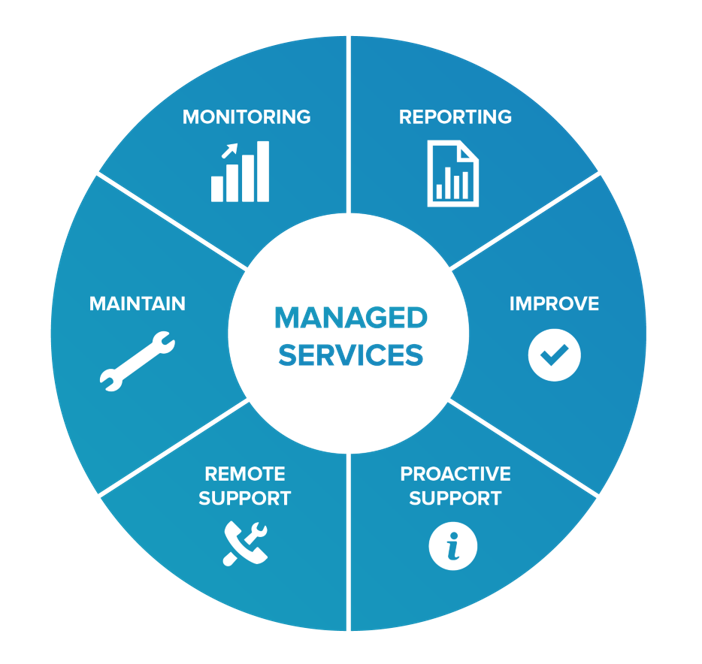The Comprehensive Guide to Recognizing Managed IT Services and Their Role in Streamlining Company Operations
In an age where innovation is integral to business success, understanding Managed IT Providers becomes an essential element for companies aiming to enhance operational effectiveness. These solutions encompass a spectrum of IT works, from cybersecurity to data monitoring, each designed to ease the burden on internal sources. As organizations browse the complexities of modern innovation, the calculated application of these solutions can cause considerable benefits. However, the subtleties of choosing the appropriate service provider and effectively incorporating these solutions call for more expedition. What implications could this have for your organization's future?

What Are Managed IT Services?
Handled IT services describe the practice of contracting out the responsibility for maintaining and expecting the need for a range of IT functions and solutions. This model makes it possible for organizations to concentrate on their core company purposes while entrusting IT administration to specialized companies (Managed IT services). Managed IT solutions incorporate different offerings, including network management, cybersecurity, data backup and recovery, cloud services, and assist desk assistance
By employing a proactive strategy, handled provider (MSPs) monitor and manage IT systems constantly, identifying possible issues before they disrupt service procedures. This preventive technique minimizes downtime and boosts system performance. Managed Services. In addition, MSPs use the most up to date modern technologies and ideal methods, making certain that organizations gain from cutting-edge options without the need for substantial capital expense
The handled IT services design is especially helpful for small to medium-sized ventures (SMEs), which may do not have the resources or expertise to maintain an in-house IT division. By leveraging the skills and understanding of outside specialists, companies can guarantee their IT framework is durable, safe, and with the ability of sustaining future development. Ultimately, handled IT solutions offer as a tactical collaboration that lines up technology with company objectives.
Trick Benefits of Managed IT Provider

Additionally, managed IT services offer accessibility to a group of experts equipped with the current expertise and abilities. This ensures that organizations stay ahead of technological developments and cybersecurity threats. With 24/7 monitoring and support, businesses can lessen downtime and swiftly address concerns, therefore enhancing productivity.
Scalability is one more crucial benefit. Handled IT solutions can conveniently adjust to a business's growth, permitting smooth assimilation of brand-new technologies and processes. This adaptability allows services to reply to market modifications swiftly.
Additionally, compliance and risk management are dramatically enhanced with handled solutions, as carriers often have durable structures in location to meet industry guidelines. Inevitably, these benefits culminate in a much more safe and secure, reliable, and competitive organization, positioning them for long-lasting success in an increasingly digital landscape.
Types of Managed IT Solutions
Organizations can choose from a variety of handled IT solutions customized to meet their certain demands and goals. One common kind is Managed Network Providers, that includes tracking and managing network efficiency, making certain security, and enhancing connection. This service is vital for keeping seamless communication and information transmission within an organization.
One more important offering is Managed Security Providers. This includes thorough options such as firewall administration, intrusion detection, and vulnerability assessments to shield delicate data against cyber threats. Provided the raising regularity of cyberattacks, this service has actually come to be essential.
Handled Cloud Solutions facilitate the migration, monitoring, and maintenance of cloud facilities (Managed IT). Services can utilize scalable resources while making sure information integrity and conformity with guidelines
Handled Aid Workdesk Services give technological support for end-users, resolving IT concerns effectively to minimize downtime and improve performance.
Last But Not Least, Managed Back-up and Disaster Recuperation solutions make certain that critical data is frequently supported and can be swiftly restored in instance of information loss cases. By understanding these varied kinds of handled IT solutions, companies can make informed choices that align with their operational approaches.

Picking the Right Provider
Picking the appropriate provider for managed IT solutions is an essential action in maximizing a company's modern technology approach. The selection process should begin with a clear understanding of your organization's particular needs and goals. Recognize the areas where you need assistance, whether it's cybersecurity, cloud services, or network administration, to make certain that potential suppliers can meet those needs.
Next, review the provider's knowledge and experience in your sector. A provider well-versed in your market will recognize the distinct difficulties and compliance needs you face. Additionally, consider their reputation; client testimonials and study can provide insight right into their integrity and efficiency.
It's also crucial to analyze the scalability of their visit here services. As your company grows, your IT needs might progress, and your supplier should be able to adjust accordingly.
Implementing Managed IT Provider
Executing managed IT solutions calls for a tactical technique to seamlessly incorporate these remedies into existing service procedures. The initial step involves evaluating the current IT landscape and recognizing specific requirements and obstacles. This clearness makes it possible for companies to customize taken care of solutions that resolve their special needs.
Next, companies should establish clear objectives and key performance indicators (KPIs) to determine the efficiency of the handled solutions - Managed IT services. This might include metrics associated with system uptime, reaction times, and individual complete satisfaction. Engaging stakeholders throughout the company is crucial to make certain buy-in and promote a smooth shift
Effective interaction with the picked managed provider (MSP) is also crucial. Setting expectations regarding solution degrees, response protocols, and escalation treatments aids foster a collective partnership. Furthermore, training employees on new systems and processes ensures they are furnished to leverage the benefits of managed IT solutions.
Conclusion
In verdict, handled IT services represent a strategic strategy to enhancing service procedures by outsourcing important IT functions. These services promote improved efficiency, cost financial savings, and continuous support while enabling organizations to concentrate on core purposes. By successfully leveraging the experience of Managed Expert, businesses can navigate the intricacies of modern-day innovation, ensuring durable cybersecurity, trusted data monitoring, and optimal system efficiency. The adoption of managed IT services is therefore essential in accomplishing long-lasting success in an affordable landscape.